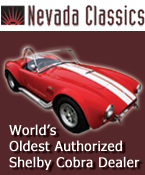 
 Main Menu
Main Menu
|
 Nevada Classics
Nevada Classics
|
 Advertise at CC
Advertise at CC
|
 February 2025
February 2025
|
| S |
M |
T |
W |
T |
F |
S |
| |
|
|
|
|
|
1 |
| 2 |
3 |
4 |
5 |
6 |
7 |
8 |
| 9 |
10 |
11 |
12 |
13 |
14 |
15 |
| 16 |
17 |
18 |
19 |
20 |
21 |
22 |
| 23 |
24 |
25 |
26 |
27 |
28 |
|
|
 CC Advertisers
CC Advertisers
|
|

08-05-2008, 01:57 AM
|
|
CC Member

|
|
|
Join Date: Mar 2005
Location: Vancouver BC Canada,
BC
Cobra Make, Engine:
Posts: 38
|
|

 Not Ranked
Not Ranked

Quote:
Originally Posted by undy

IMHO, given an experienced 1/4 miler, ET Streets/slicks/drag radials on each car and assuming the rest of the car is up to the task at hand the results would have been dramatically different. Given a good hook and the proper gearing very low 10s are possible, assuming 650 hp @ around 2600 lbs.
This is just me... but ... if I'm going to run a 650hp monster on the street or otherwise, the rest of my ride is going to be up to the task of putting all that horse power to good use 
BTW.. the M/T ET Street Drag Radials work right well in doing so.
Dave |
A decent working 2600 lb car will not need anywhere NEAR 650 HP to run low 10 second 1/4mile times. My 3100 lb Ford Fairmont bracket racer runs 10.0`s at 132 MPH with a flat tappet, iron CJ headed,single 780 vac Holley .030" over 428, shifting at 6200 rpm, with a 4 speed Jerico. I had the engine on an engine dyno last year, it made only 518HP, and just under 500 ft-lbs of torque. Dyno numbers can easily be "fudged" by correction factors, and other adjustments, such rpm per second acceleration rates. On my engine, just going from 600 rpm per sec, to 300 rpm per sec, the engine "made" almost 30 more HP. Personally, I think that although 300 rpm per sec seems to be the industry standard, I think that is too slow to be accurate in the real world. As for connecting rods, I run the 3/8" C7AE-B stock 390-438 rods, with ARP bolts. This will be the 14th year on these rods. If the budget allowed, I would go with the Crower rods, but the chinese stuff scares me. I have seen too many FE`s break the cheapo Eagle rods to risk using them.
__________________
78 Fairmont 428CJ 4speed ET10.03@132.17mph
1985 Mustang 302 5speed 12.31@106.9mph
|
-
Advertising


08-05-2008, 04:07 AM
|
 |
CC Member

|
|
|
Join Date: Jul 2005
Location: Virginia Beach, Va & Port Charlotte, Fl.,
Posts: 2,287
|
|

 Not Ranked
Not Ranked

Quote:
Originally Posted by Rory428

A decent working 2600 lb car will not need anywhere NEAR 650 HP to run low 10 second 1/4mile times. My 3100 lb Ford Fairmont bracket racer runs 10.0`s at 132 MPH with a flat tappet, iron CJ headed,single 780 vac Holley .030" over 428, shifting at 6200 rpm, with a 4 speed Jerico. I had the engine on an engine dyno last year, it made only 518HP, and just under 500 ft-lbs of torque. Dyno numbers can easily be "fudged" by correction factors, and other adjustments, such rpm per second acceleration rates. On my engine, just going from 600 rpm per sec, to 300 rpm per sec, the engine "made" almost 30 more HP. Personally, I think that although 300 rpm per sec seems to be the industry standard, I think that is too slow to be accurate in the real world. As for connecting rods, I run the 3/8" C7AE-B stock 390-438 rods, with ARP bolts. This will be the 14th year on these rods. If the budget allowed, I would go with the Crower rods, but the chinese stuff scares me. I have seen too many FE`s break the cheapo Eagle rods to risk using them.
|
Just a little apples 'n oranges there. Your fox body's set up exclusively for 1/4 mile duties. The "average" Cobra replica really isn't set up to leave like you're Faimont. The weight tranfer isn't there (typically). The average street machine just doesn't hook like a drag car, Cobra or not. My 07 Z06 traps similar to your Fairmont, but about 3/4s of a second slower through the quarter.. Reason?? 6 speed with a 62 mile an hour 1st gear and a driver that doesn't race much, . Now bring the Faimont out on a road course.....  

|

08-05-2008, 07:34 AM
|
|
CC Member

|
|
|
Join Date: Apr 1999
Location: cleveland,
OH
Cobra Make, Engine: CSX4000, 427
Posts: 1,999
|
|

 Not Ranked
Not Ranked
Quote:
Originally Posted by Excaliber

Now based on your theory/ET calculations that horse power ALWAYS equals a known ET and Trap speed I guess 800 horse would put me in the 9's? Unless you were STILL running tires that won't hook up and gearing where you shift into fourth AT the finish line or stay in third and 'run it out the back door'. What ever horse power you got if you can't hook it up, ET calculations are worthless.
|
Actually 600 HP should put you into the 9's with slicks, in the 10's with street tires, mid 10's give or take several tenths. Your trap speed should be about 130+ mph with a 600hp motor, about 120+ mph ( about 10 mph slower) with a 500hp motor. It's true that ET's are very variable,but the trap speed should be somewhat consistant whether you are using slicks or street tires.
__________________
"After jumping into an early lead, Miles pitted for no reason. He let the entire field go by before re-entering the race. The crowd was jumping up and down as he stunned the Chevrolet drivers by easily passing the entire field to finish second behind MacDonald's other team Cobra. The Corvette people were completely demoralized."
Last edited by Anthony; 08-05-2008 at 07:40 AM..
|

08-05-2008, 09:59 AM
|
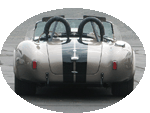 |
Half-Ass Member

|
|
|
Join Date: Jun 2005
Cobra Make, Engine: ERA #732, 428FE (447 CID), TKO600, Solid Flat Tappet Cam, Tons of Aluminum
Posts: 22,017
|
|

 Not Ranked
Not Ranked
Quote:
Originally Posted by elmariachi

Decision made: I am going with a Pond or Genesis, not sure which yet but I'll sort that out. Thanks to all who contributed this far.  |
FWIW, you might consider what I think is the "biggest bang for the buck," a seasoned 428FE block with a SCAT stroker crank and H-rods. Incredibly strong, an emissions benefit to using an iron original block (in some states), and it is still reasonably "period correct" for those that like that sort of thing.  |

08-05-2008, 05:09 PM
|
|
CC Member

|
|
|
Join Date: Mar 2001
Location: E BRUNSWICK N.J. USA,
Posts: 3,841
|
|

 Not Ranked
Not Ranked
 Barry get some popcorn and a coke
Barry get some popcorn and a coke
Barry R. I am not buying the 40 year rod story. I have a 69 AMX motor in my CJ with steel rods and crank, ARP bolts. The rebuild was done in 75. Motor is raced to 6,500 rpms. The only change to this motor was a supply line to the #5 main bearing for more oil supply and pressure to this bearing and 7 & 8 rods. I know this is not an FE motor. This motor has 40 year old rods and runs fine with 60 psi of oil pressure and 15w-40 oil. Everything I have read and from talking to Pro machinist say about the same thing, If you LIMIT the RPM range and have the CORRECT clearance for the bottom end, there should be no failures. A big part of the problem is the OIL. The rest is machinist using OLD specs for this motor. .003" or rods and mains went out the window 20+ years ago. I just got a stroker kit from you, the motor runs perfect. The balance was dead on. Here's the thing, The rod bearing are under .002" and the mains are at .002" That's a long way from .003" or more. Your a PRO builder. You have put an FE motor in EMC for the last 4-5 years. You motors are not DYNO short term motors. They are very streetable motors for driving. You use the tricks that coat parts, remove weight to the rotating assembly, and work within a set of rules. Low tension rings, controlling oil flow and limiting the top flow to the heads. For your motor you are running a stock oil pump, it uses less HP to drive. Here's the bottom line You are saying that every FE motor with FE rods that are 30-40 years old are going to break from fatigue. I do not agree. I well maintained motor and limit of RPM of under 6,000 should last 1/4 million miles. What causes motors to go bad or break bottom ends? Cheap or no oil changes, Poor machine work, DRY STARTS, you know that metal on metal rubbing before oil pressure is built up. In 80% of the times what rods or mains fail? The last ones to get OIL. #4 & #5 main, # 5,6,7,8, rod bearings. Did the FE rod have a problem, Yes with the ROD bolts. ARP fixed that, we are all running them now. Here the other practice I don't believe in Dynoing a motor with 1-2 hour of run time. IMO this is another possible cause of motor melt downs. In the old days, you built a motor, broke it in for 1/2 hour and spent the next 500-1000 mile driving normal, nothing over 3,500 rpms. Heat cycles to help get everything broken in and living together. Barry, You have been racing in your part of the woods for better than 35 years. Old school still applys today. The design of some parts are better and lighter, but I think the metal the parts are made from today are cheaper with less steel and nickle. I figure my stroker will last 8-10 years of racing it. Limit the RPM's to max of 6,200- 6,500 and I see no problem. This is kind of like the beehive springs, in the proper applications they work and run great. Again have to know the limitations, about 6,600 max. I am hoping to dyno the car in the next 2-3 weeks. I wish I was rich enough to get a 427 or 428 motor, use the 428 cast crank I have and a set of rods C9ZZ-6200A, new in the box with the change of the rod bolts to ARP, with the proper stretch work done, put it on a dyno and make 50 passes. Min HP 500-550 Torque 550-575 ft. The clearance on the mains and rods would be about .002". HPHV oil pump with a min of 60 psi at 2,500 rpms to 80 psi at 6,000+. A good oil, no synthesis. I bet the rods would do just fine. The motor would get a correct breakin with a min of 25 heat cycles. This is no different than the guys running aluminium rods for 10-20 thousand miles in street cars. All you have to do is warm the motor up to get the clearances smaller before driving. Again you and KCR are the PRO's and do this for a living. Me, I live out where the buses don't run but have learn alot in 30 years of wrenching. I make my living turning them today. Hope you and the family are well, baby must be getting big. Looking forward to your next EMC event.  Rick Lake

|

08-05-2008, 10:38 PM
|
|
CC Member

|
|
|
Join Date: Jul 2008
Location: Driftwood,
TX
Cobra Make, Engine: Contemporary Cobra, 427 side oiler
Posts: 1,850
|
|

 Not Ranked
Not Ranked
Quote:
Originally Posted by patrickt

FWIW, you might consider what I think is the "biggest bang for the buck," a seasoned 428FE block with a SCAT stroker crank and H-rods. Incredibly strong, an emissions benefit to using an iron original block (in some states), and it is still reasonably "period correct" for those that like that sort of thing.  |
I am unclear how that is any different than how I started this thread, where I was debating between an original 1969 427 block and a new one. Or are you saying that a seasoned 428 block is superior to a solid, well-tested 427 block? |

08-05-2008, 11:34 PM
|
|
Senior Club Cobra Member

|
|
|
Join Date: Jul 2002
Cobra Make, Engine:
Posts: 15,712
|
|

 Not Ranked
Not Ranked

In some ways you COULD say that. The smaller bore of the 428 block has thicker cylinder walls. The SIDE OILER 427 is a 'thin wall' casting for lighter weight. Thin wall because it also has the about the largest possible bore size in an FE. Some people say it is a good idea to sonic test the cylinder walls of a side oiler to make sure there not to thin. A .017 over bore is common to the side oiler, where as any other typical motor would go .020, .030 or more without hesitation. .020 on a side oiler is pushing the envelope of bore capability. Sometimes side oiler blocks are bored over sized and then 'sleeved' to return them to the standard size.
Now as far as the 427 CENTER OILER (or top oiler) I don't know what the specs on wall thickness are or what your limitations with that block might be. Myself I would much prefer a 427 block over a 428 simply because of the bigger bore. I prefer a big bore short stroke application over a stroker application, but thats just me. Short stroke builds rpm faster and is more consistent with the original intention/design of the 427.
If I had a 427 block there is no way I would consider a modern block over that!
Last edited by Excaliber; 08-05-2008 at 11:36 PM..
|

08-06-2008, 07:33 AM
|
 |
Half-Ass Member

|
|
|
Join Date: Jun 2005
Cobra Make, Engine: ERA #732, 428FE (447 CID), TKO600, Solid Flat Tappet Cam, Tons of Aluminum
Posts: 22,017
|
|

 Not Ranked
Not Ranked

Quote:
Originally Posted by elmariachi

I am unclear how that is any different than how I started this thread, where I was debating between an original 1969 427 block and a new one. Or are you saying that a seasoned 428 block is superior to a solid, well-tested 427 block?
|
Your first posting said you had "located" a 427SO, not purchased one (nor had it tested). IMO, except for the "coolness factor" of a SO, a seasoned, never-rebuilt, 428FE, with the extra webbing on the crank sadde, and that passes all integrity tests, is a better choice and, to a certain extent, is preferable to a new aluminum block as well. You can easily get 500HP with good drivability, wall thickness is not an issue, and you will have another rebuild down the line should you need it (without sleeving). Plus, having a late 60's early 70's block will help you pass emissions tests in many states. Not to mention that some folks prefer the originality of an iron block. Oh, and you'll save a few grand (maybe more) as well. |

08-06-2008, 08:30 AM
|
|
CC Member

|
|
|
Join Date: Jul 2008
Location: Driftwood,
TX
Cobra Make, Engine: Contemporary Cobra, 427 side oiler
Posts: 1,850
|
|

 Not Ranked
Not Ranked
Quote:
Originally Posted by patrickt

Your first posting said you had "located" a 427SO, not purchased one (nor had it tested).
|
I guess I hadn't called out that I wouldn't buy a used block if it didn't pass machine shop scrutiny and a sonic test. But I do get your point about the 428and clearly it could be a cheaper build. |

08-06-2008, 08:31 AM
|
 |
Half-Ass Member

|
|
|
Join Date: Jun 2005
Cobra Make, Engine: ERA #732, 428FE (447 CID), TKO600, Solid Flat Tappet Cam, Tons of Aluminum
Posts: 22,017
|
|

 Not Ranked
Not Ranked
Quote:
Originally Posted by elmariachi

But I do get your point about the 428and clearly it could be a cheaper build.
|
Especially if you have to do it twice.  |

08-06-2008, 08:36 AM
|
 |
CC Member

|
|
|
Join Date: Jul 2005
Location: Virginia Beach, Va & Port Charlotte, Fl.,
Posts: 2,287
|
|

 Not Ranked
Not Ranked
The 428 block is tremendously weaker all the way around than the Pond or Genisis blocks. The OEM non-cross bolted blocks had a tendancy to split down the center of the block with high HP, hence Ford's FE cross-bolted block for their flag ship. A typical 428's good for "maybe" 0.030" over bore. They also were racked with OEM core shift problems. The Pond has the "correct" date codes and casting numbers, capable of fooling any DMV. If you want bullet proof reliability Shelby, Pond or Genesis IS the only way to go.
dave
|

08-06-2008, 08:40 AM
|
 |
Half-Ass Member

|
|
|
Join Date: Jun 2005
Cobra Make, Engine: ERA #732, 428FE (447 CID), TKO600, Solid Flat Tappet Cam, Tons of Aluminum
Posts: 22,017
|
|

 Not Ranked
Not Ranked
Quote:
Originally Posted by undy

The Pond has the "correct" date codes and casting numbers, capable of fooling any DMV.
dave
|
Uhh, ok, maybe. Some of the inspectors that eyeball our Cobras are pretty savvy....  |

08-06-2008, 09:25 AM
|
|
Senior Club Cobra Member

|
|
|
Join Date: Jul 2002
Cobra Make, Engine:
Posts: 15,712
|
|

 Not Ranked
Not Ranked
While a 428 may be 'weaker' than a modern block you have to keep that in perspective, a 428 is certainly 'strong enough' for 99% of the applications it will be used in. As for the block 'splitting' that tendancy is at high rpm when built to max horse power, not really an issue unless your reving and racing it hard. As for modern blocks AND rods there are numerous examples of catastrophic engine failures. Going 'new' is not a gaurentee everything is going to be OK!
Last edited by Excaliber; 08-06-2008 at 09:30 AM..
|

08-06-2008, 11:17 AM
|
|
CC Member

|
|
|
Join Date: Jul 2003
Location: West Bloomfield,
MI
Cobra Make, Engine:
Posts: 717
|
|

 Not Ranked
Not Ranked
While a 428 is a darn good lower cost alternative, there is no way that a comparable condition 428 block is anywhere near as good as the 427 block. It's not even close. The 428 will split 100 horsepower sooner, it'll have a smaller bore by at least .100", and it will not add as much value to the car.
So - in terms of durability, power potential, or value the 427 is the better pick. In terms of usable power and fun per dollar spent the 428 (and for that matter a 390) is a very viable option.
The aftermarket FE blocks are better than any of the factory stuff by a wide margin. The Genesis block is visually identical to an OE piece externally (I can even fix the only easy to spot item...). If I were building an FE Cobra I would either run a stroked 390 for the economics, or a full out Genesis or pond based 427....
__________________
Survival Motorsports
"I can do that....."

Engine Masters Challenge Entries
91 octane - single 4bbl - mufflers
2008 - 429 cid FE HR - 675HP
2007 - 429 cid FE MR - 659HP
2006 - 434 cid FE MR - 678HP
2005 - 505 cid FE MR - 752HP
|

08-06-2008, 11:41 AM
|
 |
Senior Club Cobra Member

|
|
|
Join Date: Feb 2007
Cobra Make, Engine: KMP 539, a Ton of Aluminum
Posts: 9,592
|
|

 Not Ranked
Not Ranked
In terms of strength and durability, isn't the Shelby aluminum block built better than the Pond and Genesis? After reading many threads on CC, I ultimately decided to buy a CSX block.
|

08-06-2008, 12:44 PM
|
|
Senior Club Cobra Member

|
|
|
Join Date: Jul 2002
Cobra Make, Engine:
Posts: 15,712
|
|

 Not Ranked
Not Ranked
While it may be stronger I've seen pictures right here on Club Cobra of a Shelby block with a hole in the side! Everything is a trade off when it comes to building an engine or a car. Expense vs application vs risk, etc. As noted above a standard issue FE block (390-428) built within reasonable limits is a good cost alternative. With a hydraulic roller cam (an expensive option) you can get good horse power at or below the 6000 rpm range and maintain excellent reliability.
I would certainly prefer a 427, and a side oiler block at that, myself. Setup correctly there is no reason to fear 7000 rpm with a side oiler, they were built to take it. Now if you choose to run it at a lofty 7000 rpm your going to increase your risk of failure of SOME component no matter block what you run. The risk also goes up when you stroke it. The SHORT STROKE side oiler with a steel crank is still an excellent choice today.
Last edited by Excaliber; 08-06-2008 at 12:46 PM..
|
 Posting Rules
Posting Rules
|
You may not post new threads
You may not post replies
You may not post attachments
You may not edit your posts
HTML code is Off
|
|
|
All times are GMT -7. The time now is 03:13 AM.
|

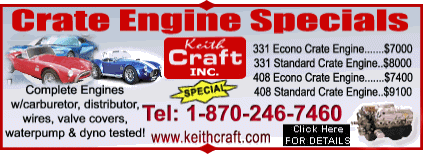



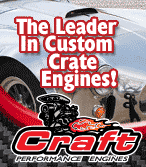

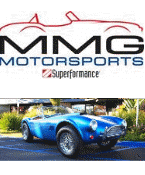
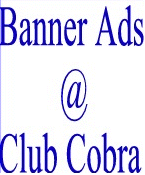
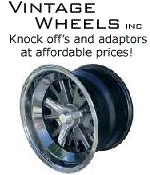
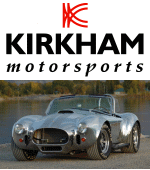

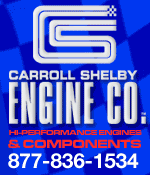









 Rick Lake
Rick Lake
 Linear Mode
Linear Mode



